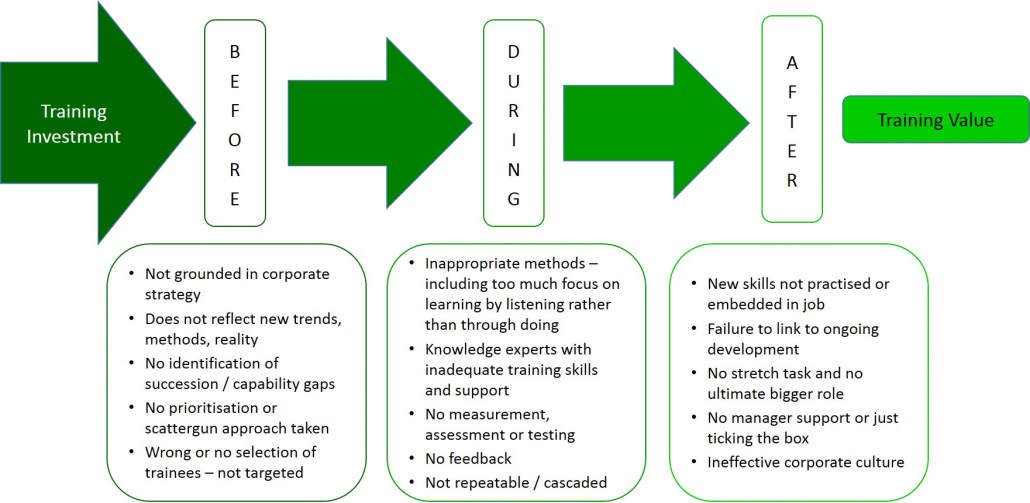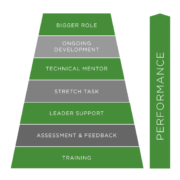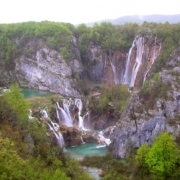Training – The Chain Of Destruction
Over the last ten years or so our experience of training in insurance has come from two different angles – one of us a trainer designing, organising and running training and development programmes across different commercial and personal insurance disciplines and in different territories, the other an underwriting manager responsible for the development of technical underwriters and in effect a user of training services.
Now working together, we have found we have a common view on the value of training and specifically how in so many cases full value is not obtained; indeed you could go as far as saying that insurance is often good at wasting the investment made in training programmes and destroying value. Others in our industry seem to agree:-
Quote 1 from Group Underwriting Director of mid-size UK Insurer:-
“All too often training is designed as a ‘sheep dip’ because it feels like the right thing to do……… If it is not targeted on the right people it creates an expectation that cannot be delivered.”
Quote 2 from Head of Learning & Development at Global Insurer:-
“I see too much DECAY – the loss of value from training when it is not embedded and supported by wider development, and not enough HARVEST which is sharing and collaboration across business units and territories.”
So, as an industry, we are not good at maximising the returns from training.
How does this happen and why?
The value of investment in training can be lost or diminished through failings in preparation, organisation, training capability, leadership and management. Shortcomings in these areas are most obvious during the specific training programme or event (for example subject matter experts not possessing adequate training skills), but in many ways it’s the issues both before the training takes place and afterwards that are more destructive.
We have produced the following model to explain how investments in training and development can be diminished – what we call “Training – the Chain of Destruction”:-

In this piece we won’t discuss all these different factors in the Chain, but we think we should say something about culture. Corporate culture is of course “the way we do things around here”. Do underwriters or claims handlers get sent on courses to increase knowledge and skills, learn a lot and then not retain the knowledge because of lack of opportunity to practise the new skills on the job – i.e. nothing is embedded? Is this down to the individual, the fault of the manager, or is it the culture?
Another example. How valuable is Electronic Multiple Choice Learning – of the type used to ensure all staff go through a new procedure or set learning? Examples usually include compliance issues such as health and safety, competition law or sanctions. Is this learning embedded or has everyone become practised in retaining the information for only 30 minutes in order to pass the test at the end of the module? Isn’t the company culture just one of ticking the box?
The purpose of our Chain of Destruction model is to highlight all the issues and make them visible – so that leaders, managers and trainers can take action to prevent them operating when considering, designing and implementing their training programmes.
At this time in the insurance industry of ultra-competitive market conditions, increasing regulatory and customer demands, expense ratio reduction and loss of technical talent and capability, increasing the value of training could not be more important. An insight from the Chief Underwriting Officer of a large insurer:-
“The industry continues to struggle with the transition in underwriting – with greater analytics and being numbers driven, but with critical human overlay. Are we training adequately within this new world?”
Measuring and putting a pound sign against the value of training is the holy grail – and many have tried and failed to do this successfully. Our view is that it is more important to identify the issues that destroy the value of training – in effect to have everything in place to negate the Chain of Destruction – and to focus on the positive requirements of what might be called a “Chain of Capability Creation”, so that the training programme produces the maximum return against the investment made.
Returning to the theme of highlighting all the issues and making them visible – we would love to hear what you think of the Chain of Destruction and to generate a debate within the insurance and training communities on the requirements for a Chain of Capability Creation.
Peter Turrell
Telephone – 07712 196133
Email: peter.turrell@maptraining.co.uk
Alan Thompson
Telephone – 07714 853224
Email: alan.thompson@maptraining.co.uk
Founders and Directors MAP Training Ltd











Leave a Reply
Want to join the discussion?Feel free to contribute!